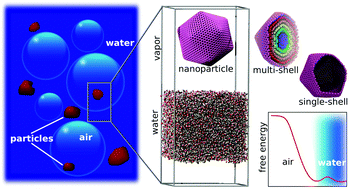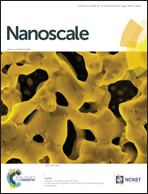Simulations of graphitic nanoparticles at air–water interfaces†
Abstract
The free energy associated with transferring a set of fullerene particles through a finite water layer is calculated using explicit solvent molecular dynamic simulations. Each fullerene particle is a carbon network of one or more spheroidal shells of graphitic carbon, and include single-shell (single-wall) or nested multi-shelled (nano-onions) structures ranging from 6 to 28 Å in radius. Corresponding changes in energy suggest a stronger affinity of carbon nano-onions for water compared to their single-shelled analogues. In the case of multi-shelled structures, the free energy profiles display a global minimum only in the bulk liquid indicating a high affinity of multi-shelled fullerene for complete hydration. Single-wall particles however, display a minimum at the air–water interface and for particles larger than 2 nm this minimum is a global minimum possessing a lower energy compared to the particle's state of complete hydration. While the propensity for single-shell particles to adsorb to the air-interface may increase with increasing particle size, there is an indication based on line tension calculations that larger single-shell particles may actually exhibit enhanced wetting compared to their smaller analogues.



 Please wait while we load your content...
Please wait while we load your content...